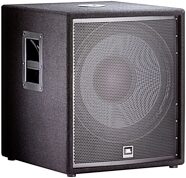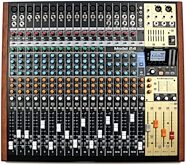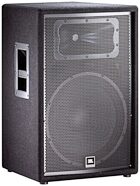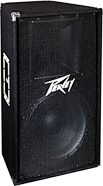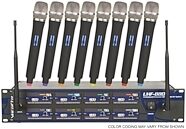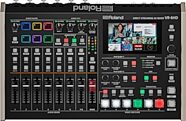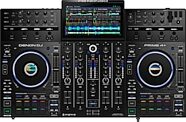Mackie M2600 FR-Series High Current Power Amplifier
No longer available at zZounds
zZounds Gear Experts Say...
500 + 500 watts @ 8 ohms stereo. 1700 watts @ 8 ohms bridged.
Overview
Three years later, the "Huh"s have turned to "WOW!"s. FR Series amps are everywhere! And with good reason. They've racked up a strong record of reliability in demanding sound reinforcement applications. And tens of thousands of satisfied owners have come to appreciate FR Series sound quality and extra system-enhancing features. Now they've proliferated inside our powered mixers, active sound reinforcement speakers and our industry-standard HR824 near-field studio monitors.
FR Series power amps don't pull power out of the ozone or switch on and off a gazillion times a second. They're traditional "lead sled" designs with massive toroid transformers, huge storage capacitors, state-of-the-art output devices and cooling systems that outperform all amps in their price ranges. They deliver enormous amounts of current into extremely low impedances - and they have dynamic power reserves to spare. The reason FR Series amps are so affordable is because of Mackie's huge investment in automated manufacturing technology, not because we cut any corners.
Cutting to the chase: FR power amps sound better than their competition when driven into clipping (overload). Since that's how 99 out of every hundred PA systems are usually operated, this is a major point.*
When an amp clips, you start hearing harmonic distortion. So conventional amps use something called negative feedback to help control clipping distortion. The output section of the amp sends a signal back to earlier stages to "throttle… read more the system down." The trouble is, this "solution" causes its own problem: During clipping, when the amp relies on negative feedback, it electronically "confuses" earlier amp stages, causing them to latch in a clipping mode instead of recovering quickly. Latching causes the amp to sound really awful when pushed too hard - which it inevitably will be.
To effectively deal with clipping, an amp must be able to recoup almost instantaneously. That's what we mean by Fast Recovery. FR Series amps use very sparing amounts of negative feedback. Then we use complementary Baker Clamp circuits on the positive and negative voltage amp stages, which prevent the stages from saturating (and latching) during periods of overdrive. An additional transistor senses when the Baker Clamp is active and then activates the FR Series amplifiers' internal limiting circuits. The result is no latching, instant recovery from overdriving the amp - and way better sound.
The more heat you can conduct away from an amp's output devices (transistors) the longer they'll last. The better physical contact that can be made between a transistor and its heat exchanger, the more heat can be pulled away and dissipated in the air. All 4 FR Series amplifier models have a mirror-polished heat exchanger that maximizes thermal transfer. This requires hand polishing the exchanger extrusion, but we think it's worth it to achieve better reliability and performance.
The exchanger itself is transverse mounted with its air inlet in the middle. Cool room air enters the front of the amp, then travels down 2 short cooling tunnels and exits on the amplifier's sides. This T-Tunnel design provides a more constant thermal gradient than one long cooling tunnel - in other words, 2 short air passages keep all transistors closer to the same temperature instead of getting processively hotter as the air temperature increases down one long exchanger.
A big advantage to owning an FR Series amp is that you get important extra features.* Features other amp manufacturers make you pay extra for or leave out all together.
Variable low cut filters for tighter bass. All PA cabinets only reproduce bass down to a certain point, called the tuned frequency. Below that point, you get audio sludge and potential woofer damage. FR Series variable low cut filters let you feed your system only the frequencies it can handle. You can "dial in" any tuned frequency from 5Hz to 170Hz. All models also include an infrasonic stabilizer circuit that cuts the really low frequencies that cause visible woofer cone flutter.
Constant Directivity Horn EQ for smoother treble. To improve high frequency reproduction, many sound systems use constant directivity (CD horns). They improve treble dispersion by more evenly distributing high frequencies. But in doing so, they actually create a frequency "dip" that reduces important frequencies anywhere from 2.5kHz to 5kHz. The old way to compensate for this was a special crossover module (hard to find and usually expensive) or a graphic equalizer (nice try, but the "cure" is worse than the problem). The M read less
FR Series power amps don't pull power out of the ozone or switch on and off a gazillion times a second. They're traditional "lead sled" designs with massive toroid transformers, huge storage capacitors, state-of-the-art output devices and cooling systems that outperform all amps in their price ranges. They deliver enormous amounts of current into extremely low impedances - and they have dynamic power reserves to spare. The reason FR Series amps are so affordable is because of Mackie's huge investment in automated manufacturing technology, not because we cut any corners.
Cutting to the chase: FR power amps sound better than their competition when driven into clipping (overload). Since that's how 99 out of every hundred PA systems are usually operated, this is a major point.*
When an amp clips, you start hearing harmonic distortion. So conventional amps use something called negative feedback to help control clipping distortion. The output section of the amp sends a signal back to earlier stages to "throttle… read more the system down." The trouble is, this "solution" causes its own problem: During clipping, when the amp relies on negative feedback, it electronically "confuses" earlier amp stages, causing them to latch in a clipping mode instead of recovering quickly. Latching causes the amp to sound really awful when pushed too hard - which it inevitably will be.
To effectively deal with clipping, an amp must be able to recoup almost instantaneously. That's what we mean by Fast Recovery. FR Series amps use very sparing amounts of negative feedback. Then we use complementary Baker Clamp circuits on the positive and negative voltage amp stages, which prevent the stages from saturating (and latching) during periods of overdrive. An additional transistor senses when the Baker Clamp is active and then activates the FR Series amplifiers' internal limiting circuits. The result is no latching, instant recovery from overdriving the amp - and way better sound.
The more heat you can conduct away from an amp's output devices (transistors) the longer they'll last. The better physical contact that can be made between a transistor and its heat exchanger, the more heat can be pulled away and dissipated in the air. All 4 FR Series amplifier models have a mirror-polished heat exchanger that maximizes thermal transfer. This requires hand polishing the exchanger extrusion, but we think it's worth it to achieve better reliability and performance.
The exchanger itself is transverse mounted with its air inlet in the middle. Cool room air enters the front of the amp, then travels down 2 short cooling tunnels and exits on the amplifier's sides. This T-Tunnel design provides a more constant thermal gradient than one long cooling tunnel - in other words, 2 short air passages keep all transistors closer to the same temperature instead of getting processively hotter as the air temperature increases down one long exchanger.
A big advantage to owning an FR Series amp is that you get important extra features.* Features other amp manufacturers make you pay extra for or leave out all together.
Variable low cut filters for tighter bass. All PA cabinets only reproduce bass down to a certain point, called the tuned frequency. Below that point, you get audio sludge and potential woofer damage. FR Series variable low cut filters let you feed your system only the frequencies it can handle. You can "dial in" any tuned frequency from 5Hz to 170Hz. All models also include an infrasonic stabilizer circuit that cuts the really low frequencies that cause visible woofer cone flutter.
Constant Directivity Horn EQ for smoother treble. To improve high frequency reproduction, many sound systems use constant directivity (CD horns). They improve treble dispersion by more evenly distributing high frequencies. But in doing so, they actually create a frequency "dip" that reduces important frequencies anywhere from 2.5kHz to 5kHz. The old way to compensate for this was a special crossover module (hard to find and usually expensive) or a graphic equalizer (nice try, but the "cure" is worse than the problem). The M read less
Specs
2600 watts @ 4 ohms bridged
1700 watts @ 8 ohms bridged
1300 + 1300 watts @ 2 ohms stereo
850 + 850 watts @ 4 ohms stereo
500 + 500 watts @ 8 ohms stereo
Total Harmonic Distortion (20Hz-20kHz, 250 mW to rated power)
2 ohms: < 0.100%
4 ohms: < 0.0
8 ohms: < 0.025%
SMPTE Intermodulation Distortion (250 mW to rated power)
2 ohms: < 0.1
4 ohms: < 0.0
8 ohms: < 0.025%
Transient Intermodulation Distortion (250 mW to rated power)
2 ohms: < 0.1
4 ohms: < 0.0
8 ohms: < 0.025%
Power Bandwidth
400 watts, 4-ohm load: 20Hz-70kHz (+0, -3dB)
Frequency Response (1 watt, 8 ohm load)
20Hz-40kHz (+0, -1dB)
10Hz-70kHz (+0, -3dB)
Electronic Crossovers
4th Order Linkwitz-Riley, switchable @ 60Hz, 90Hz & 120Hz
Low pass outputs available to internal subwoofer modes
Low pass & high pass outputs switchable to thru jacks
General
Rise time: < 4.4 usec.
Voltage Slew Rate: > 60 V/usec.
Current Slew Rate: > 30 A/usec. at 2 ohms
Gain: 32.7 dB (43 V/V)
Input Sensitivity: 1.23 volts (+4dBu)
Input Impedance: 24 kilohms balanced
Signal to Noise Ratio: (700 watts, 4 ohms) > 107dB below rated power
Transient Recovery: (20dB overdrive @ 1kHz) < 1 usec.
Turn On Delay: 3 seconds
Speaker Protection: Speaker Relay (open at turn-on & off, when DC offset is present, when short detected, or when unit is too hot)
Variable Low Cut Filter: 10Hz (off) to 170Hz
2nd Order Bessel
12db/Octave
Weight: 55 pounds; 25 kg
Width: 19" (48.3 cm) rackmountable
Height: 5.20" (13.2 cm)
Depth: 15.65" (39.8 cm)
1700 watts @ 8 ohms bridged
1300 + 1300 watts @ 2 ohms stereo
850 + 850 watts @ 4 ohms stereo
500 + 500 watts @ 8 ohms stereo
Total Harmonic Distortion (20Hz-20kHz, 250 mW to rated power)
2 ohms: < 0.100%
4 ohms: < 0.0
8 ohms: < 0.025%
SMPTE Intermodulation Distortion (250 mW to rated power)
2 ohms: < 0.1
4 ohms: < 0.0
8 ohms: < 0.025%
Transient Intermodulation Distortion (250 mW to rated power)
2 ohms: < 0.1
4 ohms: < 0.0
8 ohms: < 0.025%
Power Bandwidth
400 watts, 4-ohm load: 20Hz-70kHz (+0, -3dB)
Frequency Response (1 watt, 8 ohm load)
20Hz-40kHz (+0, -1dB)
10Hz-70kHz (+0, -3dB)
Electronic Crossovers
4th Order Linkwitz-Riley, switchable @ 60Hz, 90Hz & 120Hz
Low pass outputs available to internal subwoofer modes
Low pass & high pass outputs switchable to thru jacks
General
Rise time: < 4.4 usec.
Voltage Slew Rate: > 60 V/usec.
Current Slew Rate: > 30 A/usec. at 2 ohms
Gain: 32.7 dB (43 V/V)
Input Sensitivity: 1.23 volts (+4dBu)
Input Impedance: 24 kilohms balanced
Signal to Noise Ratio: (700 watts, 4 ohms) > 107dB below rated power
Transient Recovery: (20dB overdrive @ 1kHz) < 1 usec.
Turn On Delay: 3 seconds
Speaker Protection: Speaker Relay (open at turn-on & off, when DC offset is present, when short detected, or when unit is too hot)
Variable Low Cut Filter: 10Hz (off) to 170Hz
2nd Order Bessel
12db/Octave
Weight: 55 pounds; 25 kg
Width: 19" (48.3 cm) rackmountable
Height: 5.20" (13.2 cm)
Depth: 15.65" (39.8 cm)
Documents and Manuals
For support or warranty questions, please contact the manufacturer:
Phone: 800-898-3211
Email: support@mackie.com
Web: https://mackie.com/en/support/contact
Phone: 800-898-3211
Email: support@mackie.com
Web: https://mackie.com/en/support/contact
No longer available at zZounds
In most cases, a product is unavailable because it has been discontinued by the manufacturer
This is a carousel with product cards. Use the previous and next buttons to navigate.


